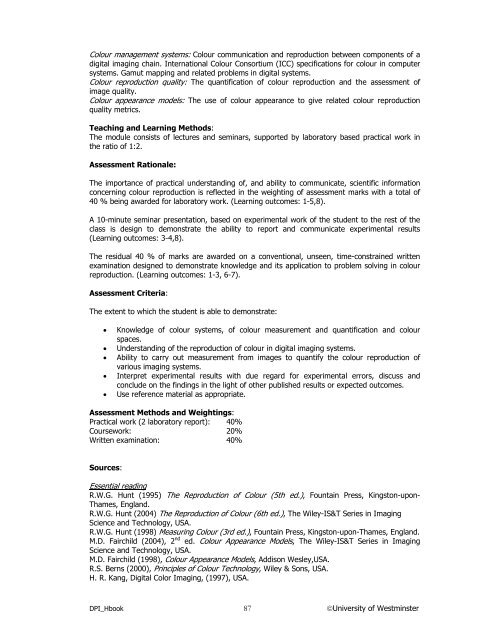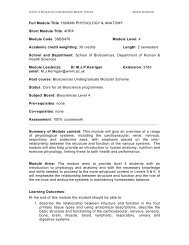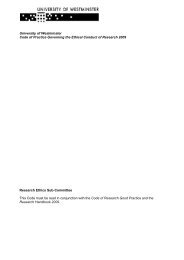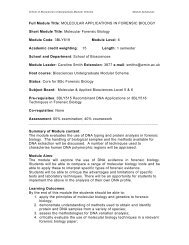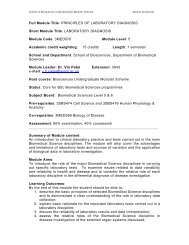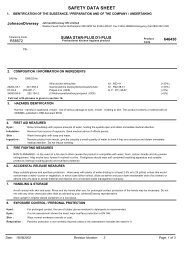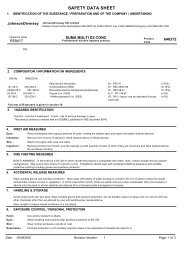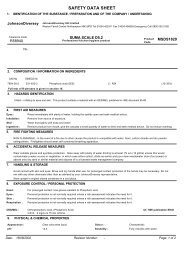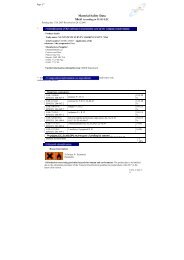CONTENTS 1. Introduction 1.1 Course Outline 1 1.2 Introduction ...
CONTENTS 1. Introduction 1.1 Course Outline 1 1.2 Introduction ...
CONTENTS 1. Introduction 1.1 Course Outline 1 1.2 Introduction ...
You also want an ePaper? Increase the reach of your titles
YUMPU automatically turns print PDFs into web optimized ePapers that Google loves.
Colour management systems: Colour communication and reproduction between components of a<br />
digital imaging chain. International Colour Consortium (ICC) specifications for colour in computer<br />
systems. Gamut mapping and related problems in digital systems.<br />
Colour reproduction quality: The quantification of colour reproduction and the assessment of<br />
image quality.<br />
Colour appearance models: The use of colour appearance to give related colour reproduction<br />
quality metrics.<br />
Teaching and Learning Methods:<br />
The module consists of lectures and seminars, supported by laboratory based practical work in<br />
the ratio of 1:2.<br />
Assessment Rationale:<br />
The importance of practical understanding of, and ability to communicate, scientific information<br />
concerning colour reproduction is reflected in the weighting of assessment marks with a total of<br />
40 % being awarded for laboratory work. (Learning outcomes: 1-5,8).<br />
A 10-minute seminar presentation, based on experimental work of the student to the rest of the<br />
class is design to demonstrate the ability to report and communicate experimental results<br />
(Learning outcomes: 3-4,8).<br />
The residual 40 % of marks are awarded on a conventional, unseen, time-constrained written<br />
examination designed to demonstrate knowledge and its application to problem solving in colour<br />
reproduction. (Learning outcomes: 1-3, 6-7).<br />
Assessment Criteria:<br />
The extent to which the student is able to demonstrate:<br />
• Knowledge of colour systems, of colour measurement and quantification and colour<br />
spaces.<br />
• Understanding of the reproduction of colour in digital imaging systems.<br />
• Ability to carry out measurement from images to quantify the colour reproduction of<br />
various imaging systems.<br />
• Interpret experimental results with due regard for experimental errors, discuss and<br />
conclude on the findings in the light of other published results or expected outcomes.<br />
• Use reference material as appropriate.<br />
Assessment Methods and Weightings:<br />
Practical work (2 laboratory report): 40%<br />
<strong>Course</strong>work: 20%<br />
Written examination: 40%<br />
Sources:<br />
Essential reading<br />
R.W.G. Hunt (1995) The Reproduction of Colour (5th ed.), Fountain Press, Kingston-upon-<br />
Thames, England.<br />
R.W.G. Hunt (2004) The Reproduction of Colour (6th ed.), The Wiley-IS&T Series in Imaging<br />
Science and Technology, USA.<br />
R.W.G. Hunt (1998) Measuring Colour (3rd ed.), Fountain Press, Kingston-upon-Thames, England.<br />
M.D. Fairchild (2004), 2 nd ed. Colour Appearance Models, The Wiley-IS&T Series in Imaging<br />
Science and Technology, USA.<br />
M.D. Fairchild (1998), Colour Appearance Models, Addison Wesley,USA.<br />
R.S. Berns (2000), Principles of Colour Technology, Wiley & Sons, USA.<br />
H. R. Kang, Digital Color Imaging, (1997), USA.<br />
DPI_Hbook 87 ©University of Westminster


